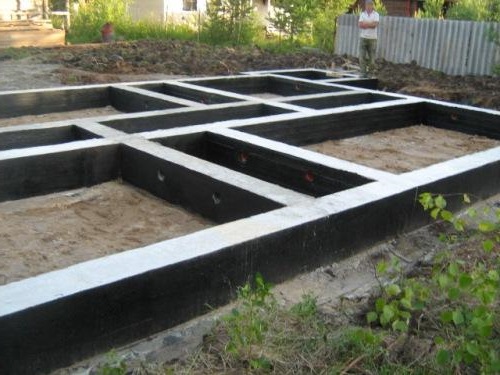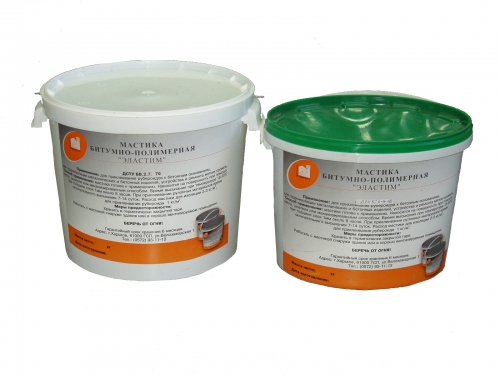Any building process is not without waterproofing. The design of such a layer not only prevents the penetration of moisture inside the room or any other design. A competently created obstacle directly affects the service life, it is significantly prolonged. This happens for the reason that the absence of a constant impact of moisture excludes the premature destruction of the materials used in the construction of materials, that is, the strength and reliability of any form increases.
Content
The current building materials market offers many options for solving this task, bituminous mastics are invariably, all the features of which are set forth below.
Types of mastik
There are quite a lot of varieties of bitumen mastic for waterproofing. Therefore, for the convenience of choosing a suitable material, they are defined in several groups. The main criteria differences are:
Important! In addition to these conditions, in the process of choosing, also consider the temperature regime when performing work, the level of professional skills, the scale of the project and the type of construction.
What are the masses on the type of application?
In this category, waterproofing mixtures of this type are presented:
- Cold applications. For the manufacture of solutions of this type, solvents or water are used as the base. The percentage ratio of bitumen in them varies in the range of 50-70%. We note some advantages of bituminous coating waterproofing of this type:
- fire safety;
- the ability to use at any convenient time without additional preparation of the mixture;
- rational labor consumption;
- the ability to use for surface treatment in residential premises.

Important! When using such a material, consider the fact that some mixtures based on solvents are provided with shrinkage.

- Hot application mastic. Such solutions require mandatory thermal processing before use. At a certain temperature, the mass becomes very plastic, which greatly facilitates the process of applying. The advantages of the materials of this type are as follows:
- lack of shrinkage when frozen;
- clamping and folding speed;
- low price;
- ability to create a seamless coating.

Important! Please note that during the preparation of the solution, it is necessary to comply with the temperature regime indicated by the manufacturer, otherwise - the finished coating of the bitumen waterproofing will not respond to specified indicators. View the video example of cooking hot mastic.
Classification of bitumen mastic in composition
In order for the selected solution to fully comply with the technical requirements and well combined with the main construction materials used to implement a specific project, before buying bitumen waterproofing, carefully read its composition.
In this respect, the following types of mixtures are distinguished:
- Rubber. This species today is in high demand. In addition to the main substance, the disperse emulsion includes a rubber crumb.
Important! Such masts most often require heating before applying.

- Mineral bitumen mastic. In the manufacture of this material, different manufacturers use various natural substances as fillers:
- Rubber mixture. In addition to very high elasticity with minor viscosity, such solutions are distinguished. Good heat resistance rates. Such a property allows them to apply them even under operating conditions with increased requirements for this indicator. The effectiveness of such a solution exceeds the results when using any other material.

- Polymer. Another type is widely used as professional builders and in everyday life in the implementation of private projects. Component composition is characterized by the greatest complexity, but also the characteristics of the strength and plasticity of the finished coating because of this better. As fillers, in addition to the bitumen, such substances are used:
- Emulsion. This type of mastic applies most often as a material for the preparation of the base before applying the main waterproofing. The composition of such a mixture is limited to the compound of water and fine-flowing bitumen dust.

- Bitumen construction. Such mastic is most difficult, since when preparing the mixture, heating is required to a temperature of 300 s, and the pouring occurs very quickly. It does not have any impurities, exclusively bitumen.

Important! When buying, consider that the price of bituminous waterproofing varies depending on the high-cost raw materials, the complexity of the formulation of the mixture and the technology of its application. Be sure to take into account these factors in the process of choice, especially when our own professional skills in the field of construction is not enough to fulfill complex procedures. Pay attention to the availability of a certificate of compliance with mastic standards to exclude the acquisition of poor-quality fake, otherwise the destruction of waterproofing will occur very quickly, which will not only create inconvenience and cause additional costs, but also can become unsafe for health.
Advantages and disadvantages
The advantages of the waterproofing protective layer on a bitumen basis quite a lot:
- High moisture protection efficiency.
- The elasticity of the coating, which practically eliminates the damage of the layer when performing subsequent works and during the operation of the structure.

- Affordable price of many species.
- Excellent adhesion indicators, which makes it possible to apply mastic on any types of surfaces, even perfectly smooth, regardless of the type of main building material.
- The seamlessness of the decorated coating is due to the appearance of leaks over time.

- Simplicity and rate of application, accessible even for self-execution without the involvement of specialists, when using cold solutions.
- Durability of operation.
- The ability to carry out construction work of this direction at any time of the year, regardless of the natural temperature regime.
- Easy transportation.
- Resistance to any aggressive environmental impact, even chemical.

Among the shortcomings, we note these features:
- the need to expect full polymerization when using certain types of mastic, otherwise all specifications will not correspond to the specified;
- hot apparent solutions are unsafe due to their flammability, so require a solid professional approach;
- the need for additional equipment when applying a hot-type mastic.

Where use bitumen waterproofing?
Further distinguishes the material of this type the versatility of use. Among all the wide opportunities, we note some of the most popular solutions:
- processing of the foundation and basement;

- arrangement of flat roofs;
- decoration of the roof when using roll or soft coatings;

- waterproofing of various floors - ceilings, walls, floors;
- creating a moisture-repellent layer in rooms with complex operating conditions - baths, reservoirs, pools, terraces, balconies, basements;

- treatment of metal floors and other parts of structures for reliable protection against corrosion.
Important! Depending on which tasks are delivered, the type of suitable bitumen mastic will vary. 
Features of using bitumen waterproofing
Mastic consumption
To understand which amount of mastic to buy to create waterproofing, carefully read the manufacturer's instructions. Typically, the pack is indicated. 
In case such recommendations are missing, but the preferred thickness of the layer is indicated, follow independently. Standard Cold Application Consumption Indicators Comply with the following values:
- 2-4 kg / m2 for the processing of the foundation;
- 3.5-6 kg / m2 during roof arrangement;
- 1-2 kg / m2 for laying a runneroid or other rolled coating.

Important! Hot mastic consumption is slightly larger, but does not exceed the maximum measure of the use of cold applying material.

Application technology
To clearly imagine the scope of work, we give an example of the most popular solution - the formation of bitumen waterproofing of the foundation. 
Carefully read the outlined instruction to make sure the simplicity of this process:
- Be proceed to perform the waterproofing layer only after the final rejection of the compound concrete.
- If there are cracks, chips and any irregularities - close them.
- Clean the surface from garbage, dust and other types of pollution.
- Apply a primer or bitumen primer with a thickness of 1-2 mm.
Important! If the emulsion of the desired type did not acquire separately, make a solution to prepare the base independently from the main mastic, collecting it with water in proportion 1: 1.
- Wait for drying.
Important! When using hot mastic, preheat the desired quantity to a temperature of 160-200 degrees. Note that it freezes it quickly enough, so correctly organize your time, taking into account the rate of application. The rational solution is a consistent heating of not the entire mass, and its individual parts for the processing of a particular area.

- Apply with a brush, spatula or a roller main waterproofing layer 2-4 mm thick.

Important! If work is carried out in winter when a temperature of a negative nature, also make a preheating mastic, but up to 40-50 degrees, to provide a flow of solution and ease of application.
- Mounting waterproofing is performed so that there are no stains and places excessive saturation solution.
- Wait a specified manufacturer of drying time.
Important! If such information on the package is not available, stick to the standard value at 5 o'clock in the technical break.

- Apply the following layer 1-2 with the same intervals.
Important! When using mastic asphalt is more than 3 layers, both during the application of some other materials, do not create.

Video
Videos, in which the analysis of the bitumen mastic and shows clearly the principle of its use in the treatment of the foundation.
Conclusion
As you have seen, the bitumen mastic for waterproofing - really the best solution. With the right choice of a suitable type and observance of simple rules of application, reliable coverage is provided to you for a long period, and the entire process of registration will not take much time.




























